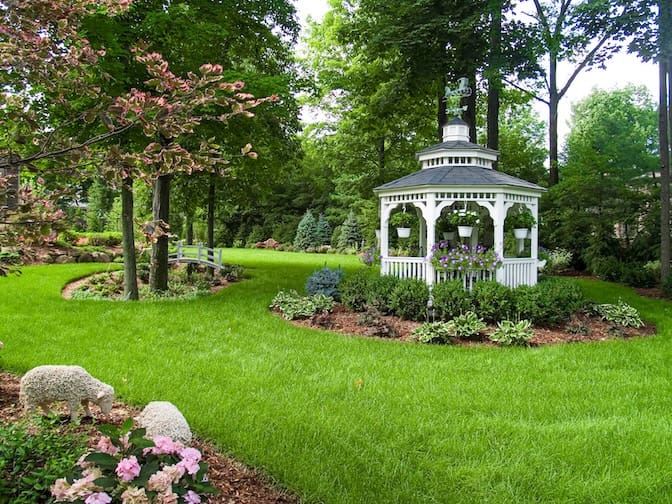Discover the Beauty and Benefits of a Biodiverse Lawn
Are you looking for a stunning lawn without the hassle of overwatering and constant mowing? Consider a biodiverse lawn—an eco-friendly and low-maintenance alternative that benefits both your yard and the planet.
Here’s why it’s a great choice:
- Eco-Friendly: Utilize native plants to create a thriving ecosystem.
- Low Maintenance: Reduce the need for mowing, watering, and chemicals.
- Supports Wildlife: Attracts bees, butterflies, and birds, enhancing local biodiversity.
Transform your outdoor space into a vibrant mini-ecosystem that requires less work and maximizes beauty. Plus, it supports local wildlife and conserves resources, making it a smart, sustainable choice.
Want to make this a reality for your property? Our team atBorst Landscape & Designis ready to assist you in making your landscape dreams come true. Call us today at(201) 785-9400orcontact us onlineto get started!
Understanding Biodiverse Lawns
What is a Biodiverse Lawn?
A biodiverse lawn is more than just grass. It’s a lively, natural landscape filled with a variety of plant species, especially native plants. Unlike traditional lawns dominated by a single type of grass, a biodiverse lawn mimics a natural ecosystem. This approach encourages a balance where plants, insects, and wildlife coexist harmoniously.
Native plants are the backbone of a biodiverse lawn. They are adapted to the local climate and soil conditions, making them hardy and low-maintenance. By using native species, you create a landscape that supports local wildlife and maintains ecological balance.
Benefits of a Biodiverse Lawn
1. Climate Resilience
A biodiverse lawn is like a superhero for your yard. With a mix of plants, it can withstand extreme weather. Whether it’s a heatwave or heavy rain, each plant species brings its strengths, ensuring your lawn stays healthy and stable.
2. Local Wildlife Support
Your lawn can be a sanctuary for local wildlife. By incorporating native plants, you provide food and shelter for birds, bees, and butterflies. These creatures play a crucial role in maintaining a balanced ecosystem.
3. Pollinator Health
Pollinators are vital for plant reproduction. A biodiverse lawn attracts bees and butterflies, boosting their populations. This helps not only your garden but also the broader environment, as these pollinators support plant life in surrounding areas.
4. Reduced Chemicals
Traditional lawns often require chemical fertilizers and pesticides. A biodiverse lawn, however, is naturally more resilient to pests and diseases. This means you can cut down on chemical use, leading to healthier soil and cleaner water runoff.
5. Ecosystem Balance
A diverse range of plants creates a balanced ecosystem. Different root structures improve soil health, while varied plant heights offer habitats for different wildlife. This synergy keeps your lawn thriving with minimal intervention.
How to Cultivate a Biodiverse Lawn
Steps to Transition
Transitioning to a biodiverse lawn is a journey toward sustainability and beauty. Here’s how you can start:
- Avoid Pesticides: Move towards organic lawn care and natural pest control. Beneficial insects and birds can manage pests for you.
- Feed the Soil: Healthy soil is the foundation of a thriving lawn. Skip chemical fertilizers and opt for compost. Leave grass clippings and mulched leaves on the lawn to naturally nourish the soil.
- Go Native with Grasses: Choose native grasses suited to your region. They are hardy and require less water and maintenance. While they might take longer to establish, they offer long-term benefits like pest resistance.
- Let Clover Take Over: Clover is a great addition to any lawn. It stays green with minimal watering and attracts beneficial insects like bees. It also enriches the soil by fixing nitrogen naturally.
- Incorporate Native Plants: Introduce native plants that bloom from spring to fall. This not only adds color but also supports local wildlife, providing food and habitat.
Enhancing Biodiversity
Once you’ve started the transition, it’s time to improve the biodiversity of your lawn:
- Pollinator Gardens: Create gardens with a variety of flowering plants to attract bees, butterflies, and other pollinators. This will boost the health of your entire yard.
- Birdhouses and Bat Houses: Install birdhouses to invite feathered friends. For natural mosquito control, consider adding a bat house. Bats can eat thousands of insects in an hour!
- Add a Water Feature: A small pond or waterfall can be a lifesaver for wildlife during dry spells. Flowing water is best to prevent mosquitoes, and it adds a soothing sound to your garden.
- Certified Wildlife Habitat: Consider getting your lawn certified as a wildlife habitat. This involves providing food, water, cover, and places to raise young. It’s a rewarding way to show your commitment to biodiversity.
By taking these steps, you’ll not only enjoy a beautiful and resilient lawn but also contribute to a healthier planet.
Diversify Your Lawn
Embracing a biodiverse lawn is more than just a trend—it’s a commitment to a healthier planet and a more vibrant home environment. At Borst Landscape & Design, we understand the importance of creating landscapes that are not only beautiful but also sustainable and eco-friendly.
Our team of experts is ready to guide you through every step of changing your lawn into a thriving ecosystem. Whether you’re interested in native plants, organic lawn care, or creating a certified wildlife habitat, we offer a full range of services to meet your needs. From design to maintenance, our comprehensive approach ensures that your lawn remains lush and biodiverse all year round.
Ready to turn your lawn? Reach out to us at(201) 785-9400or visit ourcontact pageto find out how we can help you create a yard you’ll love.
Let Borst Landscape & Design guide you in building a greener, more sustainable future.

